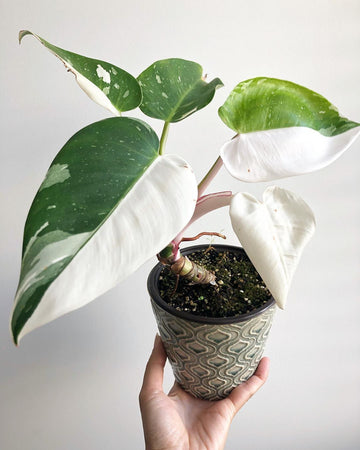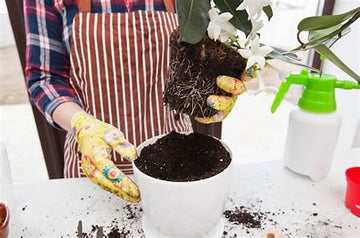Alocasia, commonly known as elephant's ear, is a striking tropical plant that needs warm, humid conditions, and is usually grown as a houseplant. It is prized for its large heart-shaped or arrow-shaped leaves and the foliage of some varieties has prominent veins or variegation. In the summer, alocasia grows quickly, producing a new leaf every week.
The plant is toxic to humans and pets.

Light
Alocasia generally thrives in bright indirect light indoors or partial shade outdoors, which prevents their leaves from scorching. The light intensity and length depend on the species or cultivar. Some large varieties tolerate full direct sunlight, and their leaf color tends to be more defined.
Generally, a location in or near a window with an eastern or western exposure offers the filtered light many species require. Some alocasia will tolerate a shadier spot in your home, but the leaf growth might be slower and less impressive.
Soil
Plant alocasia in a loose, well-drained potting mix. The soil should be slightly acidic, with a pH between 5.5 and 6.5. Use a standard all-purpose peat-based potting mix or special potting mix for aroids.
If necessary, improve the soil drainage by amending the mix with orchid bark or perlite.
Water
Alocasias are water-loving plants but allow the top few inches of soil to become nearly dry before watering. This will help keep the soil evenly moist. Soggy soil makes the plant susceptible to fungal infections and root rot.
They require less water during the winter months when the plant is dormant.
Temperature and Humidity
Alocasia does not tolerate temperatures below 60°F and requires very humid environments. To raise the humidity around your plant, place it on a tray filled with pebbles and add water until it rises to just below the pebble surface. Keep the plant away from cold drafts from windows, doors, and air conditioning.
Fertilizer
Especially larger specimens are heavy feeders. During the growing season, use a balanced houseplant fertilizer, such as 20-20-20, either in liquid form diluted to half-strength, once or twice a month, or in granular slow-release form every six weeks to two months.
Stop feeding your alocasia during its dormant phase in the winter.
Types of Alocasia
There are nearly 100 species of alocasia, and a surprisingly large number are used as houseplants. Here are some favorite species and cultivars:
- Alocasia cuprea 'Red Secret': This is a three-foot-tall plant with metallic bronze-red leaves.
- Amazonian elephant's ear (Alocasia x amazonica): A popular compact hybrid, this variety has deep green leaves and striking white or light green veins. Alocasia Polly is a cultivar whose ruffled leaves have creamy white veins.
- Alocasia zebrina: A finicky but fabulous species, it grows up to three feet tall. It's the zebra-striped stems that make this plant stand out.
-
Alocasia reginula 'Black Velvet': This type is a striking dark green plant with white veins. It is a compact plant that generally stays under 18 inches.
- Alocasia 'Tiny Dancer': This variety has graceful stems in a dancer-like silhouette and tiny leaves. It may shed its leaves during winter dormancy.
Pruning
Only prune your alocasia to remove damaged, dying, or dead foliage. Use sterile, sharp pruning shears or scissors to cut the stem of the flawed foliage at the base of the plant. It's best to prune your alocasia when it is actively growing in the spring or summer.
Propagating Alocasia
Most alocasia plants are easy to propagate by clump or rhizome division in the spring.
- Gently take the plant out of its pot and remove any excess potting soil from the rhizomes.
- Use sterile pruning shears or scissors to divide a clump of rhizomes from the central stem of the mother plant.
- Plant the rhizomes in a well-draining, evenly moist potting mix.
- Place the pot in bright indirect light and keep the potting mix consistently moist. New growth usually begins within a couple of weeks but the growth rate depends on the variety.
Potting and Repotting Alocasia
It is key to use a pot with large drainage holes for alocasia. There are pros and cons to using a porous or nonporous container for your alocasia. Clay pots allow decent airflow to the roots and soil, but nonporous plastics or glazed ceramics help maintain the even moisture these plants appreciate. Using a heavier material, like clay, helps weigh a tall plant down so it is less likely to get toppled over by a playful pet or toddler.
These fast-growing plants don't mind being slightly root-bound but need repotting when visibly outgrowing the pots. Repotting should be done in the spring or summer when the plant is actively growing. frequency depends on the type:
- Smaller varieties might need repotting every year to 18 months. Select a pot that is one to two inches larger in diameter than the current pot.
- Larger floor plants will likely only need repotting every 18 months to two years. Choose a pot that is two to four inches larger in diameter than the existing pot.
Common Pests & Plant Diseases
Alocasia plants are not commonly victims of disease. However, most alocasia species are prone to spider mites.
Alocasia Bloom
Alocasia are grown primarily for their foliage. The plants only bloom when they reach maturity and their flowers are unremarkable. Indoor plants rarely bloom. If alocasia does bloom outside, many gardeners remove the flowers to let the plant focus its energy on the foliage.
Common Problems With Alocasia
Alocasia are easy plants to grow but the following problems may occur:
Yellowing Leaves
There are several reasons why your alocasia leaves have yellowed. It's likely a watering issue—too much, or possibly too little, causes leaves to discolor this way. Alocasia needs several inches of water a week.
They also need a good amount of filtered light, and if they're receiving less than the desired amount, this often causes leaf yellowing. Their leaves can also turn yellow if they're growing in a pot that is too small. Repotting might be the answer.
Shriveled or Drooping leaves
If your alocasia suffers from drooping leaves, watering, light, or fertilization might not be adequate. These plants need even moisture, so change your watering habits if the soil is soggy or too dry. Move your plant to a spot with brighter indirect light if it is located in a shady corner, and consider feeding more regularly.





